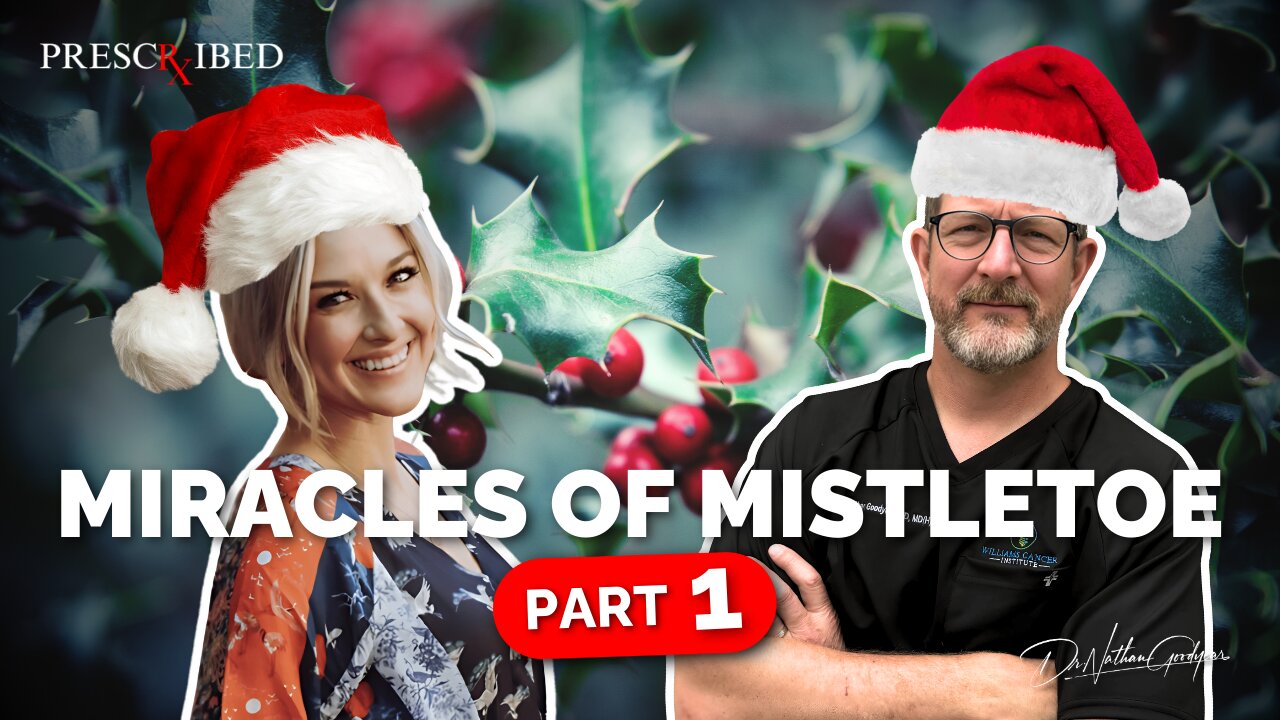Premium Only Content

Is This Christmas Plant the Secret to Beating Cancer?
Mistletoe has long been associated with the holiday season, but few people know its rich history and powerful potential in integrative oncology. In this episode of Prescribed by Dr. Nathan Goodyear, we explore the science and practical applications of mistletoe therapy in cancer treatment. Join Dr. Goodyear and Dr. Miranda LaBant as they discuss the research, mechanisms of action, and innovative ways mistletoe is being used to transform patient outcomes in oncology.
Take Action
Learn More from Dr. LaBant at https://drmirandalabant.com/
Find more cancer care resources at https://pre-scribed.com/
Watch Part 2 Now!
The Medicinal Potential of Mistletoe
Mistletoe, a semi-parasitic plant, has been used for centuries in folk medicine for its therapeutic properties. In modern integrative oncology, mistletoe therapy has gained recognition for its immune-modulating, cytotoxic, and anti-inflammatory effects. With over 7,000 research publications, mistletoe is one of the most well-studied natural remedies in cancer care.
What You’ll Learn in This Episode:
1. Historical and Cultural Roots: Mistletoe has been documented in folklore and traditional medicine for thousands of years, with its earliest references dating back to the Druids. It has since evolved from a folk remedy into a highly researched therapeutic agent in integrative oncology.
2. Types of Mistletoe: While there are over 1,200 species of mistletoe, only a few are used in medicine. European mistletoe (Viscum album), American mistletoe (Phoradendron leucarpum), and dwarf mistletoe (Arceuthobium spp.) have been studied extensively for their medicinal properties. In clinical practice, Viscum album is the most commonly used species for cancer therapy.
3. Extraction Methods: The method of extraction significantly impacts the effectiveness of mistletoe therapy. The four main extraction techniques are:
- Iskador Method: A fermented extraction process that enhances bioavailability.
- Abnoba Method: A cold extraction that preserves sensitive compounds like lectins and viscotoxins.
- Viscum Method: An aqueous extraction focusing on purity.
- Helixor Method: A cold maceration process that maintains the balance of bioactive components.
4. Mechanisms of Action:
- Immune Modulation: Mistletoe stimulates the immune system by increasing the activity and number of dendritic cells, natural killer cells, and lymphocytes. It also boosts cytokine production, enhancing the body’s natural defenses against cancer.
- Cytotoxic Effects: Mistletoe induces apoptosis (programmed cell death) in cancer cells and inhibits tumor growth by stabilizing DNA and reducing inflammation.
- Tumor Inhibition: By targeting pathways like COX-2 and VEGF, mistletoe suppresses cancer metastasis and angiogenesis (the formation of new blood vessels that feed tumors).
5. Clinical Applications:
- Subcutaneous Injections: A common delivery method that provides chronic immune stimulation. Patients can be trained to administer these injections at home.
- Intravenous Therapy: Offers a more intensive systemic approach, often used as an adjunct to chemotherapy.
- Intratumoral Therapy: Directly targets tumors, enhancing local immune responses and reducing systemic side effects.
- Intravesical Therapy: Used in bladder cancer treatment, demonstrating success in reducing recurrence rates.
6. Research Highlights:
- A German study in 2023 showed that mistletoe therapy combined with chemotherapy and hyperthermia doubled the overall survival rate in pancreatic cancer patients compared to chemotherapy alone.
- A Phase I trial at Johns Hopkins University in 2021 confirmed the safety of intravenous mistletoe, showing improved quality of life and disease control in advanced cancer patients.
Timestamps
00:00 Introduction to Integrative Oncology and Mistletoe
03:06 The Medicinal Value of Mistletoe
05:57 Understanding Mistletoe as a Folk Remedy
09:11 Types of Mistletoe and Their Applications
12:01 Mistletoe in Clinical Practice and Research
15:12 The Role of Mistletoe in Cancer Treatment
17:49 Immunotherapy and Mistletoe's Mechanisms
20:45 Research Findings on Mistletoe and Cancer
23:48 Complexities of Mistletoe Therapy
25:23 Understanding Mistletoe Extraction Methods
30:36 Mechanisms of Action in Mistletoe Therapy
35:51 Precision Cancer Care and Mistletoe
39:08 Intratumoral Approaches to Mistletoe Therapy
47:31 Future Directions in Mistletoe Research
Sources Cited in This Episode:
Wode K, et al. “Mistletoe Extract in Patients With Advanced Pancreatic Cancer: A Double-Blind, Randomized, Placebo-Controlled Trial.” Dtsch Arztebl Int. 2024 May 31;121(11):347-354. DOI:10.3238/arztebl.m2024.0080
Paller CJ, et al. “Phase I Trial of Intravenous Mistletoe Extract in Advanced Cancer.” Cancer Res Commun. 2023 Feb 28;3(2):338-346. DOI:10.1158/2767-9764.CRC-23-0002
Wode K, et al. “Mistletoe Therapy and Its Impact on Immune Modulation and Quality of Life in Cancer Patients.” Integrative Cancer Therapies. 2023.
-
 2:12:26
2:12:26
Inverted World Live
11 hours agoManhunt for Suspect in Charlie Kirk's Assassination Continues, NASA Reveals "Life" on Mars | Ep. 107
264K58 -
 2:44:02
2:44:02
TimcastIRL
12 hours agoMedia Warns Of Civil War Following Charlie Kirk Assassination | Timcast IRL
503K376 -
 2:59:56
2:59:56
Laura Loomer
13 hours agoEP143: Remembering Charlie Kirk (1993–2025)
125K88 -
 58:04
58:04
Man in America
16 hours agoCharlie Kirk’s Assassination—An URGENT WARNING for America
141K186 -
 1:22:15
1:22:15
Glenn Greenwald
14 hours agoCharlie Kirk Assassination Fallout: U.S. Reps Call for Censorship; Do Graphic Videos Serve the Public Interest? Plus: WIRED Reporter on the Dark Side of Surrogacy | SYSTEM UPDATE #513
239K213 -
 1:48:36
1:48:36
Right Side Broadcasting Network
21 hours agoLIVE: President Trump Attends the Yankees Baseball Game - 9/11/25
217K29 -
 1:54:32
1:54:32
Badlands Media
15 hours agoBadlands Media Special Coverage - FBI Press Conference on Charlie Kirk's Assassination
176K21 -
 1:06:19
1:06:19
BonginoReport
16 hours agoManhunt Underway for Charlie Kirk’s Assassin - Nightly Scroll w/ Hayley Caronia (Ep.132)
349K277 -
 1:11:42
1:11:42
Flyover Conservatives
1 day agoStructural Architect Destroys 9.11 Narrative... What Really Happened? - Richard Gage AIA | FOC Show
118K26 -
 1:51:14
1:51:14
Precision Rifle Network
19 hours agoS5E1 Guns & Grub - Charlie Kirk's "sniper"
68.6K21